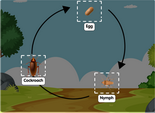Life cycle of a frog quiz
Frogs – like its other amphibian cousins - go through a curious transformation in their lives, changing from an aquatic existence into one lived fully on land.
Exploring the Life Cycle of a Frog: A Journey from Tadpole to Amphibian
The wonders of life science are endless, revealing the mysteries and transformations that every creature undergoes in its lifetime. Among the most fascinating of these natural processes is the life cycle of a frog stages. This remarkable transformation, from a tiny egg to a hopping amphibian, captures the imagination of young learners everywhere.
The Start of the Journey: Frog Eggs
Everything begins with a cluster of eggs, usually laid in calm waters. These eggs are surrounded by a jelly-like substance, which offers them some protection from predators. After a few days or weeks, depending on the species and environmental conditions, these eggs hatch to release the next stage in the life cycle of a frog.
The Aquatic Phase: Tadpoles
Emerging from the eggs are tiny, fish-like creatures known as tadpoles. In this stage, they don't yet have legs, and they possess gills to breathe underwater. Tadpoles spend most of their time swimming around, feeding on algae and other microscopic aquatic foods.
Growing Legs: The Froglet Stage
As tadpoles grow, they begin to show changes that hint at their future froggy form. Back legs sprout first, followed by the front legs. The tail, essential for swimming, starts to shrink. The gills give way to lungs as the tadpole prepares for life on land. This transitional phase, where the creature is not quite a tadpole and not yet a full-fledged frog, is referred to as the froglet stage.
The Final Transformation: Adult Frog
Finally, the tail disappears entirely, and the froglet emerges as an adult frog. Now capable of living both in water and on land, the frog starts its new phase of life. Equipped with strong legs for jumping and lungs for breathing, the frog can explore its environment, hunt for food, and eventually reproduce, continuing the cycle for the next generation.
Dive into an Interactive Quiz on the Life Cycle of a Frog
While reading about the life cycle of a frog stages provides valuable information, there's nothing quite like testing your knowledge and having some fun while you're at it. Young learners can dive into this captivating life cycle of a frog quiz to challenge themselves and see how well they've grasped the stages of a frog's life.
The Importance of Understanding Life Cycles
Getting to know the stages in the life cycle of a frog isn't just about biology; it's about understanding the intricate balance of nature. Frogs, like many amphibians, play a crucial role in their ecosystems. They help control insect populations and serve as food for various predators. Additionally, the health of frog populations can be an indicator of the overall health of an environment.
In conclusion, the life cycle of a frog is a testament to the wonders of nature and evolution. From eggs to tadpoles, then froglets, and finally adult frogs, each stage presents its own set of challenges and marvels. Encouraging kids to explore, learn, and test their knowledge through interactive tools like quizzes can foster a lifelong love for life science and the mysteries of the natural world."
Read more
Every frog starts from a tiny, jello-like egg. You might have seen clusters of tens to hundreds of these frog eggs lazily floating around in a pond or other stagnant body of water. Depending on the species, an egg will hatch in roughly one to three weeks. When it does, a fish-like tadpole swims out.
Although tadpoles are baby frogs, they look almost nothing like their adult counterparts. Much like a fish, has gills that allow it to breathe in oxygen from the water. Tadpoles love to nibble on plant matter, growing over many weeks.
A tadpole’s front half will start to appear more frog-like as it becomes a froglet. Two little hind legs have appeared that allow it to start leaping.
After a few more weeks, the froglet will have developed into a young frog. This phase nearly resembles the adult form. Only the frog’s long tail, left over from its awkward tadpole days, remain. Once this is completely lost over time, the frog will have reached maturity.
Check out our life cycle of a frog quiz here today to cement your understanding on the various phases undergone by a frog throughout its lifespan.











